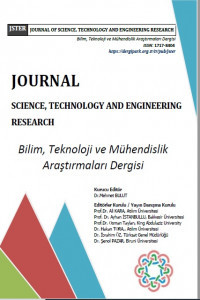Raspberry Pi 4 ile Sürücü Yorgunluk Tespiti ve Uyarı Sistemi
Gömülü Sistem, Yüz Tanıma, Yorgunluk Tespiti
Driver Fatigue Detection and Warning System with Raspberry Pi 4
Raspberry Pi, Face Detection, Fatigue Detection,
___
- T. D’Orazio, M. Leo, C. Guaragnella, A. Distante, A visual approach for driver inattention detection. Pattern Recog. 2007, 40, 2341–2355.
- M. Patel, S.K.L. Lal, D. Kavanagh, P. Rossiter, Applying Neural Network Analysis On Heart Rate Variability Data To Assess Driver Fatigue. Exp. Syst. Appl. 2011, 38, 7235–7242.
- L.M. Bergasa, J. Nuevo, M.A. Sotelo, R. Barea, M.E. Lopez, Real-Time System For Monitoring Driver Vigilance. IEEE Trans. Intell. Transport. Syst. 2006, 7, 63–77.
- Z. Zhang, J. Zhang, A new real-time eye tracking based on nonlinear unscented Kalman filter for monitoring driver fatigue. J. Contr. Theor. Appl. 2010, 8, 181–188.
- L. Pauly and D. Sankar, “Detection of drowsiness based on hog features and svm classifiers,” in 2015 IEEE International Conference on Research in Computational Intelligence and Communication Networks (ICRCICN), pp. 181–186, Nov 2015.
- A. Ercil, G. Littlewort, M. Bartlett, J. Movellan, Human Computer Interaction. Vol. 4796. Springer; Berlin, Germany: 2007. Drowsy driver detection through facial movement analysis; pp. 6–18.181–18.
- T. Danisman, I.M. Bilasco, C. Djeraba and N. Ihaddadene, 2010 “Drowsy driver detection system using eye blink patterns.” 2010 Int. Conf. Mach. Web Intell. ICMWI 2010 – Proc., pp. 230–233.
- M. Flores, J. Armingol, A. de la Escalera, Driver drowsiness warning system using visual information for both diurnal and nocturnal illumination conditions.EURASIP J. Adv. Signal Process.,2010, 438205.
- S. Mehta, S. Dadhich, S. Gumber and A.Jadhav Bhatt, “Real-Time Driver Drowsiness Detection System Using Eye Aspect Ratio and Eye ClosureRatio,”SSRN Electronic Journal, pp. 1333–1339, 2019.
- T. Soukupova and J. Cech. Real-Time Eye Blink Detection using Facial Landmarks. Center for Machine Perception, Department of Cybernetics Faculty of Electrical Engineering, Czech Technical University in Prague. Prague,2016.
- J. W. Baek, B.-g. Han, K.-j. Kim, Y.-s. Chung, and S.-i. Lee, “Real-timeDrowsiness Detection Algorithm for Driver State Monitoring Systems,”2018 Tenth International Conference on Ubiquitous and Future Net-works (ICUFN), pp. 73–75, 2018.
- Başlangıç: 2020
- Yayıncı: Mehmet BULUT
Maksimum Güç Noktası İzleme Devresi Tasarımında PI ve PID Kontrolör Parametrelerinin Belirlenmesi
Yılmaz ARIKUSU, Nevra BAYHAN, Hasan TİRYAKİ
Raspberry Pi 4 ile Sürücü Yorgunluk Tespiti ve Uyarı Sistemi
Ayşenur ŞAHİN, Sevcan ÇİL, Ayhan İSTANBULLU
Editorial ; Covid-19 Sürecinde Yeni Normal Yaşamın Elektrik Tüketimi Üzerine Etkileri
Yılmaz ARIKUSU, Mehmet Kamil KAZAKLİ, Sedat İN, Nevra BAYHAN, Hasan TİRYAKİ
Yapay Zeka Tabanlı Araç Algılama Sistemi Geliştirilmesi
Şenol PAZAR, Mehmet BULUT, Cihan UYSAL
Motor Sürücü Tasarımında Optimal Donanım Yapılarının Belirlenmesi
